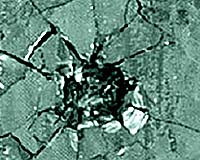 |
Leeds, UK (SPX) Oct 06, 2010 Research published by materials engineers from the University of Leeds could help pave the way towards 100% lead-free electronics. The work, carried out at the UK's synchrotron facility, Diamond Light Source, reveals the potential of a new manmade material to replace lead-based ceramics in countless electronic devices, ranging from inkjet printers and digital cameras to hospital ultrasound scanners and diesel fuel injectors. European regulations now bar the use of most lead-containing materials in electronic and electrical devices. Ceramic crystals known as 'piezoelectrics' are currently exempt from these regulations but this may change in the future, owing to growing concerns over the disposal of lead-based materials. Piezoelectric materials generate an electrical field when pressure is applied, and vice-versa. In gas igniters on ovens and fires, for example, piezoelectric crystals produce a high voltage when they are hit with a spring-loaded hammer, generating a spark across a small gap that lights the fuel. The most common piezoelectric material is a ceramic crystal called lead zirconium titanate, or PZT. Using a high intensity X-ray beam at the Diamond Light Source, the University of Leeds researchers have now shown that a simple, lead-free ceramic could potentially do the same job as PZT. "With the 'Extreme Conditions' beamline at Diamond we were able to probe the interior of the lead-free ceramic- potassium sodium bismuth titanate (KNBT) to learn more about its piezoelectric properties. We could see the changes in crystal structure actually happening while we applied the electric field," said Tim Comyn, lead investigator on the project." "PZT is the best material for the job at the moment, because it has the greatest piezoelectric effect, good physical durability, and can be radically tailored to suit particular applications," said Adam Royles, PhD student on the project. "The lead-free ceramic that we have been studying is lightweight and can be used at room temperature. This could make it an ideal choice for many applications." In the medical field, PZT is used in ultrasound transducers, where it generates sound waves and sends the echoes to a computer to convert into a picture. Piezoelectric ceramics also hold great potential for efficient energy harvesting, a possible solution for a clean sustainable energy source in the future. The Leeds team will continue to work at Diamond to study the transformation induced by an electric field at high speed (1000 times per second) and under various conditions using state of the art detectors.
Share This Article With Planet Earth
Related Links University of Leeds Space Technology News - Applications and Research
 A Catalyst Sandwich
A Catalyst SandwichEvanston IL (SPX) Oct 06, 2010 Northwestern University researchers have taken another step towards realizing a new class of polymerase chain reaction (PCR) enzyme mimics, opening the door for the development of highly sensitive chemical detection systems that go beyond nucleic acid targets. The blueprint for building synthetic structures to detect and signal the presence of targets such as small molecule medical analyte ... read more |
|
| The content herein, unless otherwise known to be public domain, are Copyright 1995-2010 - SpaceDaily. AFP and UPI Wire Stories are copyright Agence France-Presse and United Press International. ESA Portal Reports are copyright European Space Agency. All NASA sourced material is public domain. Additional copyrights may apply in whole or part to other bona fide parties. Advertising does not imply endorsement,agreement or approval of any opinions, statements or information provided by SpaceDaily on any Web page published or hosted by SpaceDaily. Privacy Statement |